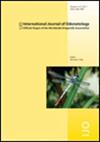森林火灾对地中海蜻蜓群落的影响
IF 1
4区 农林科学
Q3 ENTOMOLOGY
引用次数: 0
摘要
尽管网上有大量蜘蛛捕食蜻蜓/豆娘的偶然记录,但对这些相互作用的研究很少。在这里,我们描述了三海龙对研究区内两种最常见的齿状物的捕食行为,以及各种因素(网宽、网长、蜘蛛体长、齿状物体长、网距水体边缘的距离和网离地高度)是否与捕获的齿状物数量有关。三海龙采用跟踪和正面方法作为对蜻蜓的捕食策略。我们的研究结果表明,体型较大的蜻蜓会被体型较大的蜘蛛捕食。数量最多的猎物是在更宽、更高的网中捕获的,而靠近地面的窄网捕获的小猎物更多。这两个物种在离水不同距离的网中捕捉到的A.trifasciata的成功率相似。与我们的假设相反,两种猎物的捕获成功与网与水的距离之间没有关系。栖息地结构可能对这种相互作用更为重要,因为植被既吸引蜘蛛(用于锚网),也吸引齿形动物(作为栖息场所)。本文章由计算机程序翻译,如有差异,请以英文原文为准。
Effect of forest fires on a Mediterranean Odonata assemblage
Despite a high number of incidental online records of spiders predating upon dragonflies/damselflies, studies on these interactions are scarce. Here, we describe the predatory behavior of Argiope trifasciata on the two most common odonate species in the study area, and whether various factors (web width, web length, spider body length, odonate body length, distance of the web from the edge of water body, and height of the web above ground) are related to the number of odonates captured. Argiope trifasciata employed stalking and frontal approaches as Odonata predation strategies. Our findings showed that larger Odonata are preyed upon by larger spiders. The greatest numbers of prey were caught in wider, higher webs, whereas narrow webs closer to the ground caught more small prey. Capturing success by A. trifasciata was similar in webs at different distances from the water for both species. Contrary to our hypothesis, there was no relationship between capturing success in either prey species and the distance of the web from the water. Habitat architecture may be more important to this interaction, as vegetation attracts both spiders (for anchoring webs) and odonates (as perch sites).
求助全文
通过发布文献求助,成功后即可免费获取论文全文。
去求助
来源期刊

International Journal of Odonatology
ENTOMOLOGY-
CiteScore
2.30
自引率
0.00%
发文量
15
审稿时长
>12 weeks
期刊介绍:
International Journal of Odonatology (IJO) is aimed at providing a publication outlet for the growing number of students of Odonata. It will address subjects such as the ecology, ethology, physiology, genetics, taxonomy, phylogeny and geographic distribution of species. Reviews will be by invitation, but authors who plan to write a review on a subject of interest to the journal are encouraged to contact the editor.
 求助内容:
求助内容: 应助结果提醒方式:
应助结果提醒方式:


